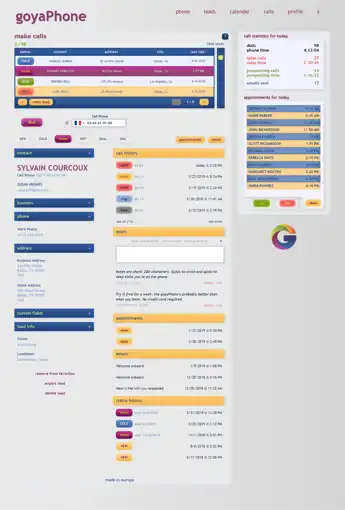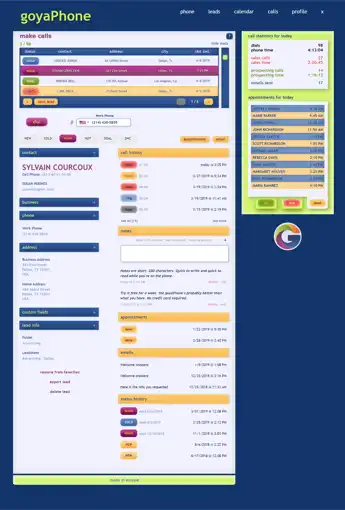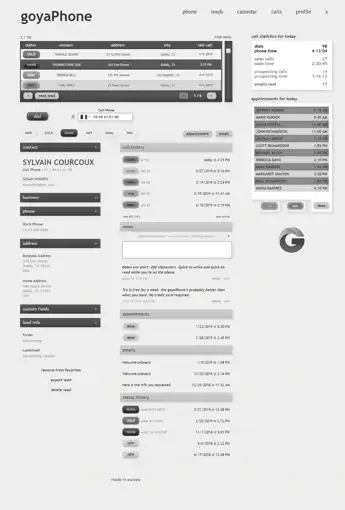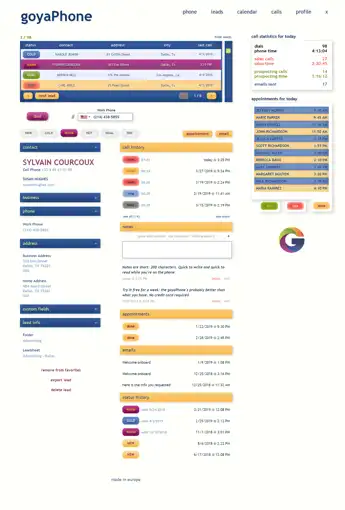Because to get more business,
you need more prospects.
A super-simple CRM that makes prospecting easy? Yes.
Closing starts with prospecting
In real estate, people say the price of a house is all about "location location location". In sales, results come from prospecting, prospecting, and more prospecting. Closing is the art, the spark of the moment, and prospecting: the daily grind. If you have to cold-call, set appointments and follow-up every day, you prospect with a phone and you absolutely hate it.
That’s where the goyaPhone comes in: it's a telephone sales software that focuses on efficiency, that uses color psychology and the gamification of cold-calling so that you make more calls, get more prospects, get more closing opportunities and more sales. Simple: become a better closer with a better software.
FRESH
COLD
WARM
HOT
GOAL
DNC
Remove the pain of prospecting
You use a phone, an email and a CRM? Feels like you're juggling from one tool to the next? The goyaPhone combines these 3 tools into just one: a CRM designed for phone prospecting.
Never again will you have to manually dial phone numbers: with the goyaPhone, you plug headsets in your computer and make calls by just clicking the dial button. And when you’re constantly sending some variation of the same prospecting emails for your follow-up? Same thing. Select an email template, make any necessary adjustments, and click send: now follow-up emails are no longer a chore. And of course, as you'd expect, you can also book your appointments right in the goyaPhone so that you'll never miss a call-back again.
The goyaPhone is everything you need to prospect, in one complete package, so that you can focus on the task instead of the tool. Everything is designed to make you forget that prospecting sucks, and you'll naturally end up making more calls, and, more importantly, more quality calls.
3 tasks? then just use 1 tool
The work you did 6 months ago counts again today
Has it ever happened in the history of sales that a person buys on the first cold-call?  Probably. But the reality is that you need hundreds of cold-calls to get a few good sales conversations, and that's where a software can make a difference: in managing the follow-up for you. Sure, you have your hot prospects, the ones you're actively working on, the ones you know about. But what about all the other people you've talked to, all the other calls you've made, all the call-back appointments, all the voicemail you left, all the emails you sent: all that work for nothing? When you're cold-calling, do you feel like a lot of your work is wasted?
Probably. But the reality is that you need hundreds of cold-calls to get a few good sales conversations, and that's where a software can make a difference: in managing the follow-up for you. Sure, you have your hot prospects, the ones you're actively working on, the ones you know about. But what about all the other people you've talked to, all the other calls you've made, all the call-back appointments, all the voicemail you left, all the emails you sent: all that work for nothing? When you're cold-calling, do you feel like a lot of your work is wasted?
 Probably. But the reality is that you need hundreds of cold-calls to get a few good sales conversations, and that's where a software can make a difference: in managing the follow-up for you. Sure, you have your hot prospects, the ones you're actively working on, the ones you know about. But what about all the other people you've talked to, all the other calls you've made, all the call-back appointments, all the voicemail you left, all the emails you sent: all that work for nothing? When you're cold-calling, do you feel like a lot of your work is wasted?
Probably. But the reality is that you need hundreds of cold-calls to get a few good sales conversations, and that's where a software can make a difference: in managing the follow-up for you. Sure, you have your hot prospects, the ones you're actively working on, the ones you know about. But what about all the other people you've talked to, all the other calls you've made, all the call-back appointments, all the voicemail you left, all the emails you sent: all that work for nothing? When you're cold-calling, do you feel like a lot of your work is wasted?The goyaPhone is designed to make the work you do every day turn into a pipeline of prospects by nurturing your leads for you. That way, you can extract prospects based on the work you've already done so that your work is not wasted anymore.
For example, a few months ago, you talked to some people: some were willing to speak with you and some even agreed to receive an email but for whatever reason, they didn't buy at that time, and you've now forgotten about them because there's no way to remember everything.
The goyaPhone prevents leads from falling through the cracks. What if you could go back through all your leads and find all the prospects you haven't talked to in a while but with whom you've had real sales interaction, and call them back today? If you have to sort through thousands of paper leads, that's going to be incredibly time-consuming.
Find the best prospects to follow-up again
If you're using a traditional CRM, it could actually be worse because in order for you to find all the prospects you haven't talked to in 6 months and to whom you had sent an email, it would mean that every time you talk or send an email to someone, you'd also have to log that activity in the CRM: the pain of prospecting combined with a data-entry nightmare? Talk about adding insult to injury! But with the goyaPhone, because the phone, the email and the CRM are combined into one integrated tool, the software remembers everything for you. It automatically generates the data you'll later need for your follow-up so that you can select prospects to call back with just a few clicks, like this:
date called
anytime
within the last 5 days
not in the last 30 days
on a specific date
custom range
call outcome
all call outcomes
leads never dialed
always voicemail or never pick up
talked less than 2 minutes
talked to more than 10 minutes
last call outcome: only prospecting calls + sales calls
sales outcome
no preference
scheduled only call-back appointments
missed last appointment
already made a sales call
this week: leads turning warm and cold
already sent an email
all my late appointments
all my upcoming appointments
leads
And in just a few clicks, the goyaPhone scans all the work you did so that you can find interesting prospects to call.
Instead of shooting darts at random at your pile of prospects, now you can decide who you're going to call back based on the work you've already done. No more wasted work. Want to call back all your late appointments: a few clicks and they're there. All the people who said "call me back later"? Well of course we're going to call you back. Find all the hard-to-reach prospects who never seem to pick-up? Can you currently find all the prospects you've dialed and who've never picked-up, in just a few clicks?
Prospecting is not just about making phone calls. It's also about what happens after the phone calls: the follow-up! And as you know, better follow-up leads to more efficient prospecting, and more sales. That's what the goyaPhone delivers: everything you need to prospect. The phone and the follow-up in just a few clicks, so that you get more sales.
The anti-CRM: because people buy with their emotions
If you've been in sales long enough, you know this for a fact: people buy with their emotions. And therefore, how you interact with prospects influences how they feel. How do you feel when you're cold-calling? Frustrated, impatient, bored... What happens when in addition to the frustration and pain of prospecting you add clunky software that's frustrating to use? More negative feelings. Finally, after 50 unfruitful calls, someone is engaging but your mind is numb, and what might have lead to something leads nowhere.  All that work wasted because of a lapse of a moment. Your software shouldn't make it worse.
All that work wasted because of a lapse of a moment. Your software shouldn't make it worse.
Now of course some people will look at the goyaPhone and its 4-color palette design and say "it doesn’t look like a professional business software, it looks like a toy", without thinking that this might actually be the intended purpose in the first place.
 All that work wasted because of a lapse of a moment. Your software shouldn't make it worse.
All that work wasted because of a lapse of a moment. Your software shouldn't make it worse.Now of course some people will look at the goyaPhone and its 4-color palette design and say "it doesn’t look like a professional business software, it looks like a toy", without thinking that this might actually be the intended purpose in the first place.
Using efficient web design, gamification techniques and the psychology of colors, the goyaPhone is designed to reduce stress and keep you in a good disposition for the few meaningful sales conversations of the day. Yes, the colors are there for a reason. If the goyaPhone can make cold-calling not only less frustrating but also more efficient, gamified and, dare we say, addictive, then you will spend more quality time on the phone, have more prospects, and more closing opportunities. The goyaPhone looks different so that you'll feel different.
Software design: the art of details
Every web designer sets out to do good design but not every web design turns out good. The key to good software design is in understanding the context in which the software will be used. The goyaPhone is not designed for the casual passer-by who might look at it and think "oh, nice colors." Nor is it designed for the first-time user who might feel overwhelmed. No, the goyaPhone is designed for the repetitive user, for people like you who need to make hundreds of calls a day, who send follow-up emails by the dozens, who need to remember call back appointments weeks or months in advance, all while keeping both motivation and a clear mind so that you can keep calm and carry on.
Time to reconsider the sales software
Because the purpose of the goyaPhone is to help you prospect over the phone, the context requires a user interface that's designed for repetitive use, over long periods of time. The user experience is tested by repeating every action 10, 20, 30 times in a row. That way, you can spot rough edges, you can reduce eye movements by repositioning the layout of visual elements, and you rework the design until each task is fluid. Then, you repeat and refine the functionality again and apply the same rigor to test how each piece of the software interacts with other parts. The goal is to minimize clicks, mouse and eye movement, so that you're as efficient as possible.
The user experience is tested by repeating every action 10, 20, 30 times in a row. That way, you can spot rough edges, you can reduce eye movements by repositioning the layout of visual elements, and you rework the design until each task is fluid. Then, you repeat and refine the functionality again and apply the same rigor to test how each piece of the software interacts with other parts. The goal is to minimize clicks, mouse and eye movement, so that you're as efficient as possible.
 The user experience is tested by repeating every action 10, 20, 30 times in a row. That way, you can spot rough edges, you can reduce eye movements by repositioning the layout of visual elements, and you rework the design until each task is fluid. Then, you repeat and refine the functionality again and apply the same rigor to test how each piece of the software interacts with other parts. The goal is to minimize clicks, mouse and eye movement, so that you're as efficient as possible.
The user experience is tested by repeating every action 10, 20, 30 times in a row. That way, you can spot rough edges, you can reduce eye movements by repositioning the layout of visual elements, and you rework the design until each task is fluid. Then, you repeat and refine the functionality again and apply the same rigor to test how each piece of the software interacts with other parts. The goal is to minimize clicks, mouse and eye movement, so that you're as efficient as possible.Software should feel like a natural extension of you instead of a carpet you're constantly tripping over because ultimately, the interface affects your behavior, and your sales.
For instance, take a very common task: selecting a time. Notice how the timepicker works in the goyaPhone. You can adjust the timepicker to your preferred time format, either the 12-hour format with AM/PM, or the 24-hour format.
12-hour format
24-hour format
with clickers
with drop-downs
As you can see, with the goyaPhone's timepicker, you can select a time in as little as 2 clicks. Compare with software that use traditional timepickers designed with drop-downs or clickers, like this:
Timepickers designed with clickers require a lot of clicking, or keyboard typing, which involves even more hand movement. With drop-downs, selecting a time requires a click to open the drop-down of the hours, a mouse movement to reach the correct option, a click to select the value and then the same operation again to select the minutes. All this while you're on the phone? What kind of timepicker does your software use?
As you'll start to use the goyaPhone, you'll come to appreciate the quality of the software and the details of its design. Take a moment to experience the user interface. Imagine if instead of cold-calling with your current system, you had the goyaPhone. Would it be better? How much time do you and your company spend on prospecting? By getting software that's specifically designed for prospecting you will get more prospects. Woody Allen says that "80% of success is showing up". The goyaPhone is designed with just that in mind: get you on the phone more often, with more prospects, on time, and in a good disposition.
The founder

My name is Sylvain and I cold-called my way out of homelessness. It was in Silicon Valley in the mortgage industry, just after the dot-com bust. I had a work visa back then and I could only work for that one company that sponsored me. I started prospecting because when business got tough at the company, the choice was simple: back to France or learn to sell, so I started making cold-calls and slept under my desk for about 6 months; taught me patience and resilience. It was really hard at the beginning but I went on for 6 years, including 2 as a sales manager. In 2007, I started my first internet startup as CEO. It was about connecting local businesses and their customers via SMS so that people could subscribe and receive promotions on their phones from the places they like. We had raised 1 million dollars: part went to outsource the development of the online platform and part was used to recruit a network of outside salespeople. At launch, there were close to 200 salespeople spread out over 17 sales offices throughout the US. Alas, when came time to turn on the website, it was so bad that I was even embarrassed to show it to the janitor. The company I had spent 2 years building imploded at launch. Everybody learned a lot of lessons.
I also realized that instead of selling our SMS advertising service with salespeople going door-to-door, it would have been a better strategy to put 50 salespeople in a room and make a million phone calls to sell our service over the phone. The investors didn't want to hear it; I was removed from the CEO position, and gradually pushed out of the company I had built. In the meantime however, I had built an app in Excel VBA that connected a spreadsheet with Skype and Outlook; very rudimentary but it worked. I wanted the company to use it but instead I was told to "take my telemarketing application and leave." So I did, and I left with the idea of building my own telemarketing software. The only caveat was that I didn't know how to program beyond Visual Basic: I didn't know the difference between a class and object and had never written a database query. I certainly didn't want to outsource software development again. So instead, I read 5,000 pages of computer books, watched hours of video tutorials, and learned how to program. I spent 5 years building the goyaPhone, working in cafés, mostly in Europe. I used my hard-learned telemarketing lessons to build the software I've always wanted. I didn't build a software for everybody; some will not like it, some will not understand it, and some will not need it. But some people will use it, like it and love it, and I built for them: the people who sell and who fight battles on the phone, everyday.
Why Goya?
Back in 2010, I took an art class at DeAnza College in Cupertino, California. It changed my perspective on art. Sometimes, artists use the power of aesthetics just to please our eyes, and sometimes it's to make us think. Sometimes it's just about making our day better, and sometimes artists spark revolutions. Here, Francisco Goya painted a scene from the Napoleonic wars of the early 19th century. He wasn't a journalist; his goal wasn't to report on what happened. Instead, he created a masterpiece he knew would far outlive him, and would make us reflect for a moment on the violence of human nature.
 Wikipedia - The Third of May 1808 by Francisco Goya
Wikipedia - The Third of May 1808 by Francisco GoyaDoes cold-calling actually work?
Some ask "does telemarketing actually work? Because I would never buy anything over the phone." Prospecting, telemarketing, telesales in the UK, inside sales, cold-calling. For some reason, telemarketing is the least politically correct while inside sales seems more polished. It's all the same job. It's a numbers game, which means you have to make lots and lots of phone calls!


You make phone calls to find people who need what you have. The bulk of business that's done over the phone is businesses selling to other businesses, not businesses selling to consumers. The phone's great because it enables direct contact with potential buyers. It may not necessarily be about making a sale: often it's about making a connection, starting a conversation, setting an appointment or just for maintaining a relationship. The sale is the climax, the point at which value changes hands. Without someone making a sale, nothing happens; sales is what makes business possible.


Asking if cold-calling works is kind of like asking "does online advertising actually work? Because I never click on those sponsored ads."
show dialpad
#
us,ca,nl,gb,au,nz,in,ie
For those who know cold-calling works
When deciding which sales software to use, most people start with what the software does, and that's important. Traditionally, sales software have consisted of a database, into which you need to constantly enter data, and some screens that display the data back to you. That's how CRMs are built, that's what they do. CRMs are data-focused. The goyaPhone is user-focused. When you're prospecting, following-up and selling, you're actually talking to people over the phone and sending emails. That's what the goyaPhone is designed for: it helps you make phone calls, send emails and remembers what you did.
For those in sales management
Selling is an art, and so is sales management: some are better at it than others. Some will spend thousands of dollars a month on salespeople, but will balk at spending 50 or 100 dollars on the right tool for the job. Others will compare two software and see a worthy consideration in saving 20 dollars. Without realizing it, some sales managers infuse a daily dose of frustration into their sales team, and it affects their bottom line.
In today's competitive markets, the choice of the right sales software is paramount. How much time and money do you spend on prospecting? Some sales software are great for sales management but impose a great deal of data entry on salespeople. Why would you want to burden your salespeople? The goyaPhone is designed for those on the front lines of prospecting. Get your salespeople a software they will like: they will thank you plenty.
Try it free for 2 weeks, no credit card required.